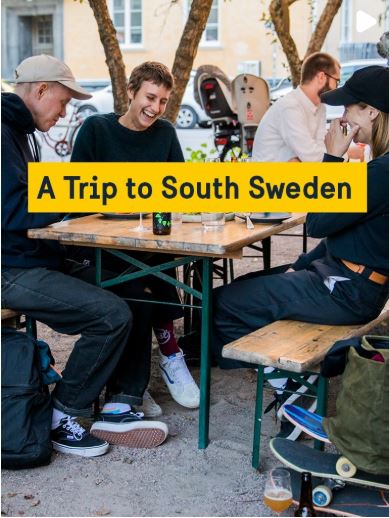Weather and nature
Who has four seasons, loves the outdoors and talks about the weather? The Swede!
Most people think of winter when they hear of Sweden. But because of the warm Gulf Stream, the weather in Sweden can be much milder than you might expect. Spring, summer, fall and winter each have their own unique personalities.
Spring runs from March/April to May, summer from June to August, fall from September to October/November and winter from November/December to March/February.
In a land as varied as Sweden, these seasons can be quite different depending on where you live. For simplicity’s sake, the country can be divided into three major regions: Götaland in the south, Svealand in the middle and Norrland in the north.
South Sweden
In Götaland, where you’ll find the cities Gothenburg and Malmö, winters are shorter and milder, while daytime summer temperatures normally range from 15 to 25 degrees Celsius. The air is relatively humid here, making warm days feel warmer and cold days colder. However, even in winter months, snow is rare near any southern coast.
Key facts about Sweden
Population: 10,587,710 people
Land area: 407,000 km²
Population density: 25.8 per Km2
Capital: Stockholm
Main language: Swedish
Currency: Swedish krona (SEK), 1 krona = 100 öre
Mid Sweden
Stretching from Stockholm in the east to the border to southern Norway in the west, Svealand has a climate that is normally a few degrees cooler than that of Götaland. Average temperatures are just below zero in January, and snowfall is more common – especially in the northwest, where a number of popular ski resorts are located.
North Sweden
Although relatively few people live here, Norrland has the climate many people falsely associate with all of Sweden. Winters here are long, cold and dry, with sub-zero temperatures lasting several months. There is also much more snow here. Summers may be short, but temperatures are often a comfortable 15 degrees, with occasional peaks of up to 30 degrees.
Swedish landscape
The Swedish countryside is dotted with thousands of lakes, freshwater streams, mountains and rolling hills. Starting up north, villages are few and small, nature fills in. The landscape is very dramatic, and rolling hills rise into mountains. On the way south, you’ll pass by endless numbers of lakes, streams, and pine and birch trees.
On the Baltic island of Gotland, limestone columns rise dramatically from the sea. And in southernmost Sweden, you’ll find everything from deep-green potato fields to some of the richest apple orchards in Europe.
So if there’s one thing Sweden has plenty of, it’s open landscapes. Even those living in large cities like Stockholm or Gothenburg have direct access to hundreds of unspoiled islands – just a short boat ride from the city centre.
Daylight
Although the Swedish winters seem cold and dark, the long summer days are well worth the wait. In most of the country, people stay outdoors well into the night, chatting in parks and outdoor cafés as the sun barely dips below the horizon.
As far south as Malmö, summer daylight outlasts the average person’s waking hours. And in the far north, the sun never sets for weeks at a time.
Time
Sweden is located in the Central European Time (CET) zone. Like in other European countries, summer time is also observed here. This means that the clock is set forward one hour, from the last weekend in March to the last weekend in October, in order to gain more daylight.
Winter
Winter, as you might expect, is dark and cold across most of the country. In midwinter, the sun doesn't rise above the horizon north of the Arctic Circle. But you might be lucky to experience the sky lit up by northern lights.
Though there will be more daylight hours the further south you go, this is the time of year when people either stay indoors or gear up for winter sports. Family and friends come over for dinner, living rooms are lit by candlelight and most people look forward to holidays like Lucia, Christmas and winter breaks with their children.
'Allemansrätten'
Sweden is filled with forests and open landscapes and one of the unique joys of living in Sweden is allemansrätten, or the right of public access. It allows anyone to roam freely in the countryside, swim and travel by boat in someone else’s waters and pick mushrooms and berries in the forest.
Although landowners can put up signs to exclude visitors from certain private lands, and areas that are particularly vulnerable to damage are always off-limits, the general rule is that visitors are allowed to walk across lands at a reasonable distance from houses, yards, gardens and fenced-in areas. With this right comes the responsibility to tread carefully and to show consideration for landowners and others.
As long as the land is not cultivated, and as long as no damage is caused, this means that most of Sweden’s nature is yours to explore. Except for the area nearest a person’s house, you’re even free to camp or park a motor home on another person’s land for up to 24 hours. After this, you’ll need the landowner’s permission to stay.
Because it has existed for generations, allemansrätten is a part of the national identity of Sweden. School groups explore the forests from an early age and families often fish, pick berries or go for walks in the woods together. Many people can identify a surprising number of birds, fish and trees by name. And nearly everyone knows where to find their secret patch of chanterelles, sometimes known in Swedish as ‘the gold of the forest’.

